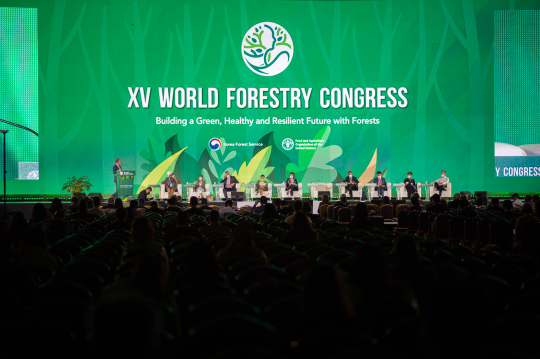When we watch the news or read a newspaper article related to the forests, it often focuses on environmental problems, such as the negative effects of climate change, or the destruction of the forests. However, sustainable forestry is the opposite: it is beneficial for the environment, it contributes to mitigating the impacts of a changing climate, and it offers renewable alternatives to plastic, clothing, buildings, and more.
Every six years or so, thousands of people gather in venues to discuss different aspects of forestry. This year, the XV World Forestry Congress of the Food and Agriculture Organization of the United Nations (FAO) was held May 2-6, in Seoul, Republic of Korea. This year's theme was: Building a Green, Healthy, and Resilient Future with Forests.
High-level session to talk about wood
Politicians, diplomats, and scientists came together to talk about forests. Dozens of sessions were deployed every day in the agenda and took place in the rooms, some of them with the capacity to seat more than a thousand people.
One of the most exciting sessions was: Wood the most ancient raw material taking us to the future.
The session included speakers such as Thais Linhares Juvenal, Senior Forestry Officer of FAO; H. E. Rosalie Matondo, Minister of Forestry Economy of the Republic of the Congo; Sheam Satkuru, Executive Director of the International Tropical Timber Organization (ITTO), Vincent Guallart, General Director of Urban Habitat, among others.
The most innovative part of the session was the one presented by Robert Grace, co-founder of M&C Saatchi Group of Creative Companies in South Africa and known as the Chief Simplicity Officer.
Need to change the mindset
Many people are worried about the use of products that come from trees. They think about the loss of beautiful forests and all the problems associated with deforestation.
However, many people don't know that using wood products coming from sustainable forestry helps to restore the forests, increase the capture of CO2 with the growing process of the new trees, and contribute to the local and global economy, among other aspects.
Wood products are part of a sustainable solution, according to Robert Grace.
A communication campaign is needed
During the session, the main message was that there is a need to change society's mindset to choose sustainable wood as a replacement for fossil and mineral-based materials, and the need for a campaign to do so, and I agreed. We need a communication campaign where the public and private sectors participate together to promote the use of sustainable wood products around the world.
Wood can often replace plastic and other petroleum products. Innovation has led to the creation of options where wood is used for food, technology, clothing, and even health. Now, also tall buildings are being built with wood. Did you know that the tallest timber building is located in Norway, has 18 floors, and is called the Mjøstårnet building?
So, our responsibility now is to start using more products made of wood and make sure that it comes from sustainable forestry.
I believe that this is a decision that is in our hands, in each person, regardless of their age or their origin. Deciding on a sustainable solution is an individual decision that would have a global impact.
About the author
Marianela Argüello L. lives in the rural area of Costa Rica, a country that according to the Government of Costa Rica (2022), has doubled its forest cover since 1990, managing to reverse deforestation by going from 34% in 1977, to 52% today.
She has done volunteer work in Skogsvårstyrelsen, in Övertorneå, northern Sweden. This taught her about the benefits and challenges of forestry at a completely different latitude.
She has also worked for the Forestry Program at the Tropical Agricultural Research and Higher Education Center (CATIE).
By the end of 2018, she assumed the coordination role of the Latin American and Caribbean Forest and Environmental Communicators Networks (Recofalc, by its Spanish acronym), which is an initiative of the Forestry Division, of the United Nations Food and Agriculture Organization (FAO).
Reference

